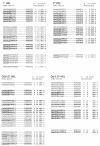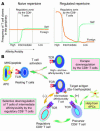An affinity/avidity model of peripheral T cell regulation
- PMID: 15668735
- PMCID: PMC544609
- DOI: 10.1172/JCI23879
An affinity/avidity model of peripheral T cell regulation
Abstract
We show in these studies that Qa-1-dependent CD8+ T cells are involved in the establishment and maintenance of peripheral self tolerance as well as facilitating affinity maturation of CD4+ T cells responding to foreign antigen. We provide experimental evidence that the strategy used by the Qa-1-dependent CD8+ T cells to accomplish both these tasks in vivo is to selectively downregulate T cell clones that respond to both self and foreign antigens with intermediate, not high or low, affinity/avidity. Thus, the immune system evolved to regulate peripheral immunity using a unified mechanism that efficiently and effectively permits the system to safeguard peripheral self tolerance yet promote the capacity to deal with foreign invaders.
Figures





Similar articles
-
How the immune system achieves self-nonself discrimination during adaptive immunity.Adv Immunol. 2009;102:95-133. doi: 10.1016/S0065-2776(09)01202-4. Adv Immunol. 2009. PMID: 19477320 Review.
-
Maintaining or breaking CD8+ T-cell tolerance to beta islet cell antigens: lessons from transgenic mouse models.J Autoimmun. 2004 Mar;22(2):115-20. doi: 10.1016/j.jaut.2003.10.004. J Autoimmun. 2004. PMID: 14987739 Review. No abstract available.
-
Thymocyte antigens do not induce tolerance in the CD4+ T cell compartment.J Immunol. 1999 Nov 1;163(9):4851-8. J Immunol. 1999. PMID: 10528186
-
The Qa-1 dependent CD8+ T cell mediated regulatory pathway.Cell Mol Immunol. 2005 Jun;2(3):161-7. Cell Mol Immunol. 2005. PMID: 16212882 Review.
-
CD4+ T cells mature in the absence of MHC class I and class II expression in Ly-6A.2 transgenic mice.J Immunol. 1998 Jul 1;161(1):175-82. J Immunol. 1998. PMID: 9647222
Cited by
-
The specificity of T cell regulation that enables self-nonself discrimination in the periphery.Proc Natl Acad Sci U S A. 2009 Jan 13;106(2):534-9. doi: 10.1073/pnas.0811843106. Epub 2008 Dec 31. Proc Natl Acad Sci U S A. 2009. PMID: 19118203 Free PMC article.
-
Potential link between MHC-self-peptide presentation and hematopoiesis; the analysis of HLA-DR expression in CD34-positive cells and self-peptide presentation repertoires of MHC molecules associated with paroxysmal nocturnal hemoglobinuria.Cell Biochem Biophys. 2013 Apr;65(3):321-33. doi: 10.1007/s12013-012-9435-1. Cell Biochem Biophys. 2013. PMID: 23076633 Free PMC article.
-
FOXP3 expression is upregulated in CD4T cells in progressive HIV-1 infection and is a marker of disease severity.PLoS One. 2010 Jul 23;5(7):e11762. doi: 10.1371/journal.pone.0011762. PLoS One. 2010. PMID: 20668701 Free PMC article.
-
Evaluation of a DLA-79 allele associated with multiple immune-mediated diseases in dogs.Immunogenetics. 2016 Mar;68(3):205-17. doi: 10.1007/s00251-015-0894-6. Epub 2015 Dec 28. Immunogenetics. 2016. PMID: 26711123 Free PMC article.
-
Novel Autologous Dendritic Cell Therapy AVT001 for Type 1 Diabetes.NEJM Evid. 2024 Jul;3(7):EVIDoa2300238. doi: 10.1056/EVIDoa2300238. Epub 2024 Jun 25. NEJM Evid. 2024. PMID: 38916421 Free PMC article. Clinical Trial.
References
-
- Kappler JW, Roehm N, Marrack P. T cell tolerance by clonal elimination in the thymus. Cell. 1987;49:273–280. - PubMed
-
- Bouneaud C, Kourilsky P, Bousso P. Impact of negative selection on the T cell repertoire reactive to a self-peptide: a large fraction of T cell clones escapes clonal deletion. Immunity. 2000;13:829–840. - PubMed
-
- Kuchroo VK, et al. T cell response in experimental autoimmune encephalomyelitis (EAE): role of self and cross-reactive antigens in shaping, tuning, and regulating the autopathogenic T cell repertoire. Annu. Rev. Immunol. 2002;20:101–123. - PubMed
-
- Jiang H, Chess L. The specific regulation of immune responses by CD8+ T cells restricted by the MHC class IB molecule, Qa-1. Annu. Rev. Immunol. 2000;18:185–216. - PubMed
Publication types
MeSH terms
Substances
Grants and funding
LinkOut - more resources
Full Text Sources
Other Literature Sources
Research Materials

